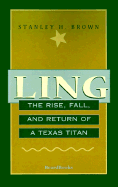|
|
|
|
||||||

|
Ling: The Rise, Fall, and Return of a Texas Titan
By Stanley H. Brown 1999/01 - Beard Books 1893122301 - Paperback - Reprint - 319 pp. US$34.95 The story of Jim Ling, one of the greatest players of corporate games, who convinced some of Wall Street's smartest people that he had a foolproof system for making money. Publisher Comments Jim Ling, whose education never went beyond high school and electrician's training in World War II, became CEO of Ling-Temco-Vought in 1963, the fourteenth largest corporation on Fortune's 500 list. He discovered a way to create free money, at least for a while. He called his series of acquisitions and spin-offs Project Redeployment. While it worked, it was dazzling. In fact, he believed in his venture so completely that he kept all his own and his children's money in his company's stock, only to be eventually wiped out. Review by Gail Owens Hoelscher Summed up neatly, this is Jim Ling, founder and CEO of Ling-Temco-Vought, once the fourteenth-largest corporation on the Fortune 500 list: That he was able to get control of – and combine – the sixth largest steel company, the eighth largest airline, the eighth largest defense contractor, the third largest meat packer, the largest sporting-goods maker, and a string of other companies in an almost random group of industries may well be the most significant thing to be said about him. Or maybe it is the fact that he performed all this from a base of little education, no connections, no money, no status, no leverage of any kind, but solely on the strength of what he discovered and created. As fascinating as Ling was, this book offers so much more. Stanley H. Brown presents a remarkable knowledge of and intriguing insights into corporate history and institutional behavior. He understands what makes organizations work, whether corporate, religious, or military. Although it has been more than 25 years since Jim Ling was on top of the world, he and his story remain hard to beat. He was a man of integrity. Faced with defeat, he conjured up innovative solutions. He picked up the pieces and tried something else, and even investors once burned went back for more. He believed in himself and his ventures absolutely, so much so that he kept all his won money and his children’s money in LTV stock, and was wiped out when it went bust. Ling was born one of six in Hugo, Oklahoma. A devout Catholic in the fundamentalist Bible Belt, his father killed a fellow worker in a rage after years of enduring anti-Catholic torment and, although acquitted, was so racked with guilt he left the family to live in a monastery. Ling’s mother died when he was eleven. He never finished high school. After a short stint in the Navy during World War II, during which time he became an electrician, he started Ling Electric in Dallas. Post-war Dallas was good to bright men who worked hard. The company grew exponentially. Ling discovered public investors and began infusing them with his enthusiasm, enthusiasm that made them hand over lots of money to him. And he began to acquire companies at a dizzying pace, bigger and bigger companies: meatpacker Wilson & Co., steelmaker Jones & Laughlin, Braniff Airlines, LTV Aerospace, Wilson Sporting Goods, and many other, smaller companies. He was masterful financier with seemingly endless ideas on making money work. So where did it go wrong? Ling’s over-conglomerated conglomerate spun out of control. He was a micromanager extraordinaire and kept too much decision-making power to himself. He was a victim of his own success and overfed ego. He fought long and hard with the Justice Department in an antitrust suit over Jones & Laughlin, but the country’s suspicion of conglomerates in the late 1960s got the better of him. In the end, he was ousted by his own people but, true to form, went on to try something new. The author researched this book very thoroughly. He convinced Ling to keep a journal during some critical moments and interviewed all the major players. Read it for the story of Ling, but also to learn about what makes people tick. Stanley H. Brown is a former writer and editor at Business Week, Fortune, and Forbes. His columns have appeared in numerous publications. Comments from the Author |
|
|
|
home
| about us
| contact us
| related
sites |